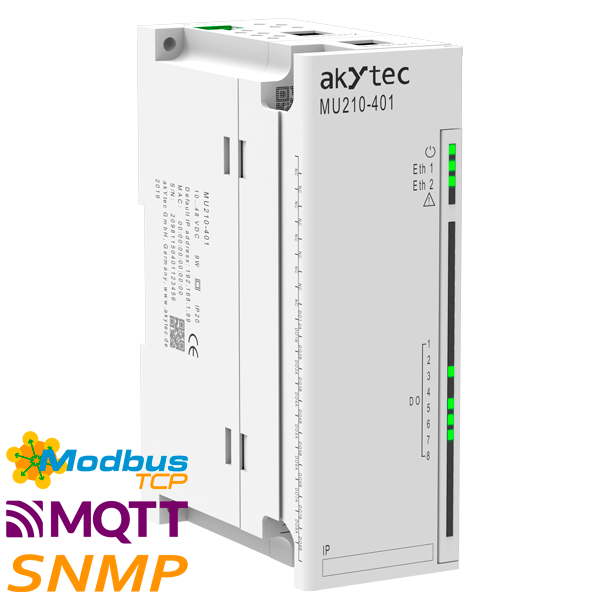When selecting discrete output modules, it's important to consider their type, characteristics, and applications. akYtec offers modules with various types of discrete outputs: electromagnetic relays, PNP, and Push-Pull. Each type has its advantages, disadvantages, and specific applications. Let's take a closer look at each of them.
Differences between PNP, Push-Pull and Relay Outputs
PNP Outputs PNP outputs, also known as "high-side" outputs, work as follows: when a low logical signal (logical 0) is applied to the base of a PNP transistor, the transistor switches on and supplies power to the load connected to the collector. This means PNP outputs "push" current to the load. In these circuits, the load is connected between the output and ground.
PNP outputs are common in industrial automation and are often used in systems where devices are powered from a single DC source.

Fig. 1 Wiring of a high-side output
Push-Pull Outputs Push-Pull outputs use both PNP and NPN transistors. In this configuration, one transistor "pushes" current to the load, while the other "pulls" current from the load to ground. As a result, Push-Pull outputs can both supply power to and draw power from the load, making them more versatile.
In Push-Pull configurations, the load is connected between the outputs of two transistors, allowing these circuits to provide bidirectional current control. This is especially useful in applications where rapid changes in current direction are required.

Fig. 2 Wiring of a push-pull output
Relay Outputs Relay outputs use electromechanical relays to control loads. Relays are devices that can open or close contacts under the influence of a control signal, allowing relay outputs to control both small and large loads.

Fig. 3 Wiring of relayl output
Advantages and Disadvantages
Advantages of PNP Outputs
- PNP outputs are easy to integrate into systems requiring simple load control.
- Widely used in the industry and compatible with many types of loads.
- Simple circuits reduce the likelihood of failures and simplify diagnostics.
Disadvantages of PNP Outputs
- PNP outputs can only supply current to the load, limiting their application.
- In industrial environments, PNP outputs may be sensitive to electromagnetic interference.
- Like Push-Pull transistors, PNP outputs have limitations in current and voltage.
Advantages of Push-Pull Outputs
- Can both supply and draw current, allowing for more complex tasks.
- Push-Pull outputs provide quick response times, crucial for high-frequency switching applications.
- The differential nature of the signals helps reduce the impact of electromagnetic interference.
- Have a wide range of applications, from motor control to precise actuator control.
Disadvantages of Push-Pull Outputs
- Like PNP transistors, Push-Pull outputs have limitations in current and voltage.
Advantages of Relay Outputs
- Relay outputs can control high-voltage and high-current loads, making them versatile.
- Relays provide electrical isolation between control and controlled circuits, protecting electronics from high voltages and interference.
- Relay outputs are often used in high-temperature or vibration-prone environments, where semiconductor devices may be less reliable.
Disadvantages of Relay Outputs
- Relay outputs have significant inertia and can be slow compared to semiconductor devices.
- Relays require more space and can be heavy, especially for high-power applications.
- Limited number of switching operations

akYtec Discrete Output Modules
In the akYtec catalog, you can find several types of discrete output modules, each with unique characteristics and designed to solve specific tasks:
- MU210-401, MU210-402, MU210-403: Modules with relay outputs.
- MU210-412: Module with Push-Pull (DO1…8) and PNP (DO9…DO24) outputs.

|
Modification |
MU210-401 |
MU210-402 |
MU210-403 |
MU210-412 |
|
|
Number of outputs |
8 DO |
16 DO |
24 DO |
24 DO |
|
|
Outputs type |
relay |
PNP |
Push-Pull |
||
|
Discrete output (DO) characteristics |
|||||
|
Galvanic isolation of outputs |
Isolation of each channel except DO1 and DO2 |
Isolation of each channel |
Group isolation: DO1-DO2 ... DO7-DO8; DO17-DO18...DO23-DO24 |
– |
|
|
Galvanic insulation |
1780 V |
– |
|||
|
Operation mode |
Logic state switching; PWM signal generation. |
Logic signal switching; Generation of a low-frequency PWM signal; Generation of a high-frequency PWM signal (only the first 8 outputs); Generation of a pre-set number of pulses (first 3 outputs only). |
|||
|
DC load current, max. |
5 A for 250 V, 50 Hz and cos φ=0.4 |
0,4 А |
0,15 А |
||
|
Output power supply |
250 VAC |
10…36 VDC |
|||
|
Switching on/off time |
15 ms |
– |
|||
|
Output frequency (for resistive load), max. |
1 Hz |
1 Hz |
60000 Hz |
||
|
Output pulse length, min |
50 ms |
1 ms |
5 µs |
||
Conclusion
When choosing a discrete output module from akYtec, it's essential to consider the type of outputs, their number, the presence of galvanic isolation, and operating modes. Depending on your requirements for switching speed, switching capability, and specific application conditions, you can select the most suitable module from the company's range.


